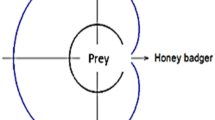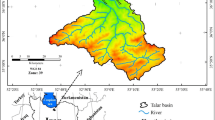Abstract
The essential minimum velocity required to prevent sediment deposition was predicted in this study using soft computing. The Radial Basis Function (RBF) network was utilized, and particle swarm optimization (PSO) was used to determine the radial basis function (RBF) parameters. The factors that influence sediment transport to the limit of deposition are determined first, and they are classified in different dimensionless groups. Then, different models are presented in order to consider the effect of each of the dimensionless parameters. The densimetric Froude number (Fr) was predicted through using RBFN-PSO. The results of RBFN-PSO also were compared with the results of RBFN-BP, indicating that RBFN-PSO is more accurate than RBFN-BP and predicts Fr with an acceptable level of accuracy (RMSE = 0.037, MARE = 0.092). Also, a sensitivity analysis is employed to assign the most significant variable for the Fr prediction.




Similar content being viewed by others
References
ASCE (1970) Design and construction of sanitary and storm sewers. Manual and Reports on Engineering Practices, No. 37, American Society of Civil Engineers, Reston
Banasiak R (2008) Hydraulic performance of sewer pipes with deposited sediments. Water Sci Technol 57:1743–1748. doi:10.2166/wst.2008.287
British Standard BS8005-1 (1987) Sewerage guide to new sewerage construction. British Standard Institution, London
Butler D, May R, Ackers J (2003) Self-cleansing sewer design based on sediment transport principles. J Hydraul Eng 129:276–282. doi:10.1061/(ASCE)0733-9429(2003)129:4(276)
Cigizoglu HK (2003) Estimation, forecasting and extrapolation of flow data by artificial neural networks. Hydrol Sci J 48:349–361. doi:10.1623/hysj.48.3.349.45288
Dawson WC, Wilby R (1998) An artificial neural network approach to rainfall-runoff modelling. Hydrol Sci J 43:47–66. doi:10.1080/02626669809492102
Ebtehaj I, Bonakdari H (2013) Evaluation of sediment transport in sewer using artificial neural network. Eng Appl Comput Fluid Mech 7:382–392.
Ebtehaj I, Bonakdari H (2014a) Performance evaluation of adaptive neural fuzzy inference system for sediment transport in sewers. Water Resour Manage 28:4765–4779. doi:10.1007/s11269-014-0774-0
Ebtehaj I, Bonakdari H (2014b) Comparison of genetic algorithm and imperialist competitive algorithms in predicting bed load transport in clean pipe. Water Sci Technol 70(10):1695–1701. doi:10.2166/wst.2014.434
Ebtehaj I, Bonakdari H, Sharifi A (2014) Design criteria for sediment transport in sewers based on self-cleansing concept. J Zhejiang Univ-Sci A 15:914–924. doi:10.1631/jzus.A1300135
Kaydani H, Najafzadeh M, Mohebbi A (2014) Wellhead choke performance in oil well pipeline systems based on genetic programming. J Pipeline Sys Eng Pract 5(3):06014001. doi:10.1061/(ASCE)PS.1949-1204.0000165
Legates DR, McCabe GJ (1999) Evaluating the use of goodness-of-fit measures in hydrologic and hydroclimatic model validation. Water Resour Res 35:233–241. doi:10.1029/1998WR900018
Mayerle R, Nalluri C, Novak P (1991) Sediment transport in rigid bed conveyance. J Hydraul Res 29:475–495. doi:10.1080/00221689109498969
Najafzadeh M, Sattar AM (2015) Neuro-fuzzy GMDH approach to predict longitudinal dispersion in water networks. Water Resour Manag 29(7):2205–2219. doi:10.1007/s11269-015-0936-8
Najafzadeh M, Zahiri A (2015) Neuro-fuzzy GMDH-based evolutionary algorithms to predict flow discharge in straight compound channels. J Hydrol Eng 20(12):04015035. doi:10.1061/(ASCE)HE.1943-5584.0001185
Najafzadeh M (2015) Neuro-fuzzy GMDH based particle swarm optimization for prediction of scour depth at downstream of grade control structures. Eng Sci Technol Int J 18(1):42–51. doi:10.1016/j.jestch.2014.09.002
Najafzadeh M, Tafarojnoruz A (2016) Neuro-fuzzy GMDH based particle swarm optimization to predict longitudinal dispersion coefficients in rivers. Environ. Earth Sci 75(2):1–12. doi:10.1007/s12665-015-4877-6
Najafzadeh M, Barani GA, Hessami-Kermani MR (2015) Evaluation of GMDH networks for prediction of local scour depth at bridge abutments in coarse sediments with thinly armored beds. Ocean Eng 104:387–396. doi:10.1016/j.oceaneng.2015.05.016
Najafzadeh M, Balf MR, Rashedi E (2016a) Prediction of maximum scour depth around piers with debris accumulation using EPR, MT, and GEP models. J Hydroinform 18(5):867–884. doi:10.2166/hydro.2016.212
Ota JJ, Perrusquia GS (2013) Particle velocity and sediment transport at the limit of deposition in sewers. Water Sci Technol 67:959–967. doi:10.2166/wst.2013.646
Qasem SN, Shamsuddin SM (2011) Radial basis function network based on time variant multi-objective particle swarm optimization for medical diseases diagnosis. Appl Soft Comput 11(1):1427–1438. doi:10.1016/j.asoc.2010.04.014
Qasem SN, Shamsuddin SM, Hashim SZM, Darus M, Al-Shammari E (2013) Memetic multiobjective particle swarm optimization-based radial basis function network for classification problems. Inf Sci 239(1):165–190. doi:10.1016/j.ins.2013.03.021
May RWP, Ackers JC, Butler D, John S (1996) Development of design methodology for self-cleansing sewers. Water Sci Technol 33:195–205. doi:10.1016/0273-1223(96)00387-3
Vongvisessomjai N, Tingsanchali T, Babel MS (2010) Non-deposition design criteria for sewers with part-full flow. Urban Water J 7:61–77. doi:10.1080/15730620903242824
Zaji AH, Bonakdari H (2014) Performance evaluation of two different neural network and particle swarm optimization methods for prediction of discharge capacity of modified triangular side weirs. Flow Meas Instrum 40:149–156. doi:10.1016/j.flowmeasinst.2014.10.002
Bonakdari H, Ebtehaj I (2014a) Verification of equation for non-deposition sediment transport in flood water canals. 7th International conference on fluvial hydraulics, RIVER FLOW 2014, Lausanne, Switzerland, 3–5 September, pp 1527–1533. doi:10.1201/b17133-203
Bonakdari H, Ebtehaj I (2014b) Study of sediment transport using soft computing technique. 7th international conference on fluvial hydraulics, RIVER FLOW 2014, Lausanne, Switzerland, 3–5 September, pp 933–940. doi:10.1201/b17133-126
European Standard EN 752-4 (1997) Drain and sewer system outside building: Part 4. Hydraulic design and environmental considerations, Brussels: CEN (European Committee for Standardization)
Kennedy J, Eberhart R (1995) Particle swarm optimization. In: Proceeding of the international conference on neural networks, Perth, Austalia, pp 1942–1948
Lindholm OG (1984) Pollutant loads from combined sewer systems. In: Proceedings of the 3rd international conference on urban storm drainage, Gothenburg, Sweden
Najafzadeh M, Laucelli DB, Zahiri A (2016b) Application of model tree and evolutionary polynomial regression for evaluation of sediment transport in pipes. KSCE J Civ Eng. doi:10.1007/s12205-016-1784-7
Najafzadeh M, Bonakdari H (2016) Application of a neuro-fuzzy GMDH model for predicting the velocity at limit of deposition in storm sewers. J Pipeline Syst Eng Pract 06016003. doi:10.1061/(ASCE)PS.1949-1204.0000249
Shi Y, Eberhart RC (1998) Parameter selection in particle swarm optimization. In: Porto VW, Saravanan N, Waagen D, Eiben AE (eds) Evolutionary programming VII, pp 611–616
Ab Ghani A (1993) Sediment transport in sewers. Ph.D. Thesis, University of Newcastle Upon Tyne, UK
Qasem SN, Shamsuddin SM, Hassanien AE (2009) Hybrid learning enhancement of RBF network with particle swarm optimization. Foundation of computational intelligence: studies in computational intelligence, vol 201. Springer, Berlin/Heidelberg, pp 381–397. doi:10.1007/978-3-642-01082-8_15
Ota JJ, Nalluri C (2003) Urban storm sewer design: approach in consideration of sediments. J Hydraul Eng 129:291–297. doi:10.1061/(ASCE)0733-9429(2003)129:4(291)
Zaji AH, Bonakdari H (2015) Application of artificial neural network and genetic programming models for estimating the longitudinal velocity field in open channel junctions. Flow Meas Instrum 41, 81–89. doi:10.1016/j.flowmeasinst.2014.10.011
Author information
Authors and Affiliations
Corresponding author
Rights and permissions
About this article
Cite this article
Qasem, S.N., Ebtehaj, I. & Bonakdari, H. Potential of radial basis function network with particle swarm optimization for prediction of sediment transport at the limit of deposition in a clean pipe. Sustain. Water Resour. Manag. 3, 391–401 (2017). https://doi.org/10.1007/s40899-017-0104-9
Received:
Accepted:
Published:
Issue Date:
DOI: https://doi.org/10.1007/s40899-017-0104-9




